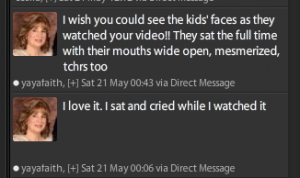many lessons learned …
I thought I would share a recent experience of global collaboration. Through the wonders of Twitter I connected with a teacher in Chicago – we first started corresponding a few months ago – you know the sort of thing “We must get the kids to collaborate one day” . Well over the past few weeks we have found a purpose as it appeared that both groups of children we work with were studying Endangered animals. My Chicago colleague got the ball rolling and created a Voicethread with the sketches and poems created by her students. This is how it progressed
- Voicethread by Chicago
- Blog Posts by Australian students
- Blog posts read and commented by Chicago
- Blog post material added to Voicethread
- Australian students respond to Chicago students with facts about Koala
- Chicago school creates Introductory video for Australian school
- Australian school responds with video about Melbourne
- Voicethread continues to evolve with comments both ways
If you looked at the planning documents for both schools, I know that neither set of teachers would have anticipated this when planning their units on Endangered animals. The events flowed from each – evolved out of the collaboration and on the spot ideas. If the teachers were not open to spontaneously changing their planned pathways, the benefit from the opportunity would have been lost.
So what did the students get out of this ? Well, I know the Australian kids had to consider what had been presented and design a suitable reply – adding to the prior knowledge with their own facts. They had an immediate audience for their writing – they were not just writing a poster for the classroom wall – they were genuinely informing another person (or group), in this case a 8 year old child in Chicago (and her class). They were exposed to other children’s ideas and presentations – they were an audience as well as creators. The students were teaching each other. If nothing else, the students were exposed to a global collaboration, they saw how simple tools can connect people. Perhaps next time they have information to share they might say “How about we find another class to work with?” or “Could we learn from other students?”.
 Another thing that struck me is that this learning is definitely not all for the students – the teachers participated in a sharp learning curve – creating the Voicethread, sharing it, creating iMovies to share and emailing and Twittering all along to share the developing issues. There were glitches and the time difference and fast approaching summer vacation in the USA meant we fast forwarded some processes – but these are the approaches you have to take when collaborating on a global scale.
Another thing that struck me is that this learning is definitely not all for the students – the teachers participated in a sharp learning curve – creating the Voicethread, sharing it, creating iMovies to share and emailing and Twittering all along to share the developing issues. There were glitches and the time difference and fast approaching summer vacation in the USA meant we fast forwarded some processes – but these are the approaches you have to take when collaborating on a global scale.
So when I woke up this morning and saw these Tweets from my new ‘American friend’ – I was heartwarmed, gratified and overall happy.

 Whilst our intentions are student centred, I accept that one powerful by-product of class blogs is the sharing of ideas amongst the adult readers. Through blogging, teachers are sharing practical ideas and lesson content. Teaching methods are being modelled and exposed in a way that could not occur before the immediate tool of blogging became widespread. I know that often the teachers are more excited than the students when they receive comments and I credit this to the affirmation that they receive from colleagues. This affirmation is so important and has been lacking in schools where the doors are closed to outsiders – thankfully those days are over.
Whilst our intentions are student centred, I accept that one powerful by-product of class blogs is the sharing of ideas amongst the adult readers. Through blogging, teachers are sharing practical ideas and lesson content. Teaching methods are being modelled and exposed in a way that could not occur before the immediate tool of blogging became widespread. I know that often the teachers are more excited than the students when they receive comments and I credit this to the affirmation that they receive from colleagues. This affirmation is so important and has been lacking in schools where the doors are closed to outsiders – thankfully those days are over.



